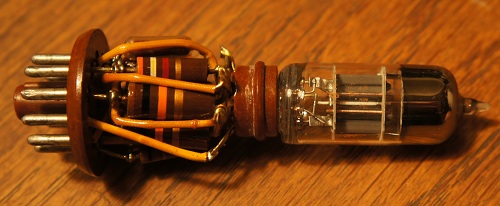The Ware for July 2011 is shown below. Click on the image for a much larger version.
It’s the summer of retro wares!
Also, if you haven’t read it yet, Phil Torrone wrote up a nice article about why every maker should learn chinese. I think his article is a nice juxtaposition to these cold-war relics. It puts into perspective how much the world has changed since the days of McCarthyism…

My gut screams Philbrick op-amp when I see the pic, but I can’t find one that used a single tube. The construction certainly reminds me of their early tube op-amps. Maybe it’s not an op-amp, but a buffer instead? Or a diff amp, using a two element tube?
Nevermind, it’s an early digital module possible from EECO. Looks a lot like the EECO standard packaging. If it’s an 11 pin plug, it could be a Z-90052 flipflop, a Z-90392 flipflop, a Z-90049 squaring circuit, a Z-90023 pentagrid circuit, or a Z-90053 dual cathode follower.
Link to the EECO catalog: http://www.philbrickarchive.org/eeco_1960.zip
My guess is that it is a double triode configured as a flip-flop to make a module that is part of an early computer or similar numerical machine.
Guess I got locked out for too many comments too quickly?
I’m thinking it’s a EECO digital module, as seen in the catalog at: http://www.philbrickarchive.org/eeco_1960.zip
The 11 pin candidates would include Z-90052 flipflop, Z-90392 flipflop, Z-90049 squaring circuit, Z-90023 pentagrid circuit, and the Z-90053 dual cathode follower.
The two identical resistors would tend to rule out the Z-90023.
Others beat me to it. It looks very much like a pluggable module for a very early electronic computer. If this is the case, the tube contains multiple active components (equivalents of FETs) and the supporting passives are stacked underneath.
Peterson, in this case, the passives are litterally “supporting” the tube ;)
I came to the same deduction : computer element from a tube computer using a double triode…
This looks like a THD Yellow Jacket (http://www.thdelectronics.com/product_page_yellowjacket.html). Only made to vintage specs :)
– Mike
The tube is a 7-pin dual triode with a common cathode, which only matches the 5964 in those diagrams. By itself, that narrows it down to the Z-90052 F/F, or the Z-90049 Squaring Circuit. As the Squaring Circuit has an 8-pin plug, and the pictured one has more, I’m going to say it’s the Z-90052 Flip-flop.
Photomultiplier Tube?
I’ll say its a flip-flop circuit from a Univac computer.
I saw a bunch of these for sale in a surplus electronics store around 1968, so its pretty old!
There are some very odd postings creeping in to this! Some are clearly spam, but others seem to be replying to other threads.
Sounds like we need some kind of spam protection here… this is getting ridiculous.
Sorry, I just got around to cleaning the cruft. I’m not sure why so much spam is getting through suddenly, I’m using anti-spam filters but maybe the bots that are doing the spamming just got a lot more sophisticated…just fyi, I’m currently getting spam at a rate of one spam submission per minute, so most of them are being filtered correctly.
Octal may have had heaters wired in series or series/parallel. Socket mod includes adjustment for heater voltage of miniature tube – 7 pin?
In these days of austerity along with relative stress about running into debt, lots of people balk resistant to the idea of having a credit card in order to make purchase of merchandise or perhaps pay for any occasion, preferring, instead to rely on the tried and trusted way of making settlement – raw cash. However, if you’ve got the cash on hand to make the purchase in full, then, paradoxically, this is the best time for you to use the credit cards for several good reasons.